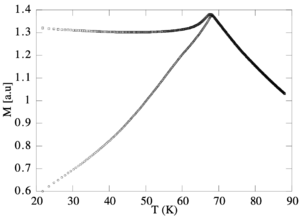T-4
Goal: Understand some physical properties of mean-field spin glasses in the low-T phase: the structure of the free-energy landscape, the response of the system to applied magnetic fields.
Key concepts: full-RSB, magnetic susceptibility, linear response.
Replica solutions: a classification
- 1-RSB. We have seen an example of mean-field model, the spherical -spin, in which the low-T phase is glassy, described by a 1-RSB ansatz of the overlap matrix. The equilibrium in the glassy phase is described by three quantities: the typical overlap between configurations belonging to the same pure state, the typical overlap between configurations belonging to different pure states, and the probability that two configurations extracted at equilibrium belong to the same state. It can be shown that the low-T, frozen phase of the REM is also described by this 1-RSB ansatz with and .
- full-RSB. The Sherrington-Kirkpatrick model introduced in Lecture 1 also has a low-T phase that is glassy. However, the structure of the free-energy landscape is more complicated and encoded in a complicated pattern of the mutual overlaps between equilibrium states. To understand it, let us consider a 2-RSB ansatz for the overlap matrix:
- Properties.
Problems
Problem 4.1: magnetic susceptibilities and linear response
In an Ising system, the thermodynamic magnetic susceptibility is defined as
where is the magnetization at a given inverse temperature and external field , and its finite-size counterpart. The function measures the response to changes of the magnetic field.
- Ferromagnetism. Using the self-consistent equation for the magnetization in the mean-field Ising model, , show that diverges exactly at the transition temperature .
-
Spin glass. By the Fluctuation-Dissipation Theorem (FDT), we know that the response and correlations at equilibrium are related by
In a spin glass, by symmetry with respect to sign flips of the couplings it holds for . Show that one can write
and thus that this quantity does not diverge at the transition to the spin-glass phase.
- “Failure” of linear response. The quantity is however not what one measures in linear response in spin glasses! Indeed, is the response that one would measure if the system is prepared at equilibrium, then a small magnetic field is applied and the system is given enough time to reach the new equilibrium state. [1] In linear response, one would measure however the response of the system which is confined to a given pure state: in analogy with the above, what would you expect to be its expression in terms of the overlaps? Could you explain intuitively why ?

- Experiments. The plot on the left shows experimental measurements of the magnetic susceptibility in a spin-glass. The two curves correspond to two different protocols: (i) ZFC (zero-field cooled) protocol: cool the system at low T, add a very small magnetic field when the system is already at the final low temperature; (ii) FC (field-cooled): cooling the system in presence of a small magnetic field and comparing the observed magnetization with the one measured without this small magnetic field. In the second protocol, the system has the ability to choose the state that is most appropriate in presence of the applied field. Which of the the two susceptibilities defined above describe these two experimental protocols?
Comment: the magnetic susceptibility does not diverge at the spin-glass critical temperature. One can identify a more complicated object, the spin-glass susceptibility , that does diverge at the transition. At variance with the magnetic susceptibility, that is related to a 2-point function (the correlation, which involves two spins), the spin-glass susceptibility is associated to a 4-point function. This is consistent with the fact that the order parameter of the spin-glass phase, , is itself a 2-point function, while the magnetization that is a 1-point function. -->





















![{\displaystyle m={\text{tanh}}[\beta (h+m)]}](https://wikimedia.org/api/rest_v1/media/math/render/svg/1dfcdced87574901b35a0adfa0581f1c8787fd38)







